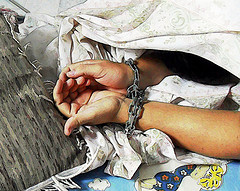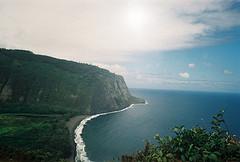The crime of human trafficking includes either forced labor or sexual exploitation, where coercion or fraud is used to control the victim. In the United States, this set of crimes is defined and addressed through the Victims of Trafficking and Violence Prevention Act of 2000, reauthorized in 2003, 2005, and 2008. Provisions of the act cover steps for preventing trafficking, for prosecuting perpetrators, and for providing protection and services to victims. In the thirteen years since the passage of this legislation, much has been written about U.S. trafficking policy – mostly focused on national issues, rather than on varied local contexts.
My research uses interviews, official data, and field work to take a close look at human trafficking in the state of Hawai`i – and, importantly, I have gathered information in three different islands in the state, to see if Maui and the Big Island experience human trafficking issues differently from the main island of Oahu.
Special Challenges for Addressing Human Trafficking in Hawai`i

I find that trafficking and the related steps to address it have many distinctive features, both in Hawai’i compared to mainland U.S. states and in the particular islands.
- Geographic constraints. Hawaiian victims of sexual exploitation or other kinds of forced labor find it more difficult to run away given the constraints of living on islands. With ocean all around, quick and cheap escapes are hard to achieve.
- Ethnic diversity hampers services for potential victims. Hawai`i’s migrant labor force is much more ethnically diverse than in most mainland states. Agricultural laborers in Hawai`i come from Mexico, Southeast Asia, East Asia, Micronesia, or other Pacific Islands – and Micronesian workers alone speak a dozen different languages. Service providers find it hard to get access to appropriate translation services, and outreach programs have tough choices to make about the language and cultural style of public service announcements aimed at informing potential victims of their rights and options to get help.
- The after-effects of failed prosecutions. Informants in my research said that high-profile trafficking cases that ended in dropped charges against the agro-businesses Aloun Farms and Global Horizons could undercut future efforts. Highly publicized failures at prosecution may lead victims to be unsure about what counts as illegal human trafficking and cause perpetrators to think they can get away with exploiting workers.
Challenges Unique to the Rural Hawaiian Islands
Islands in the Hawaiian chain other than Oahu are relatively isolated rural areas where people who experience trafficking or try to prevent or prosecute it face additional challenges.
- Uneven resources and infrastructure. Capacities to combat human trafficking in Hawaii tend to be concentrated on Oahu – including expertise, funding, service programs, and other relevant resources. People fighting human trafficking on the neighboring, smaller islands often cited lack of resources as a big impediment to their efforts. In addition, coordination of efforts with allies on Oahu often requires costly and tedious travel for service providers on the outer islands.
- Limited mobility in remote communities. Victims who face limited mobility on any island can be further entrapped in vast rural areas, where victims, actual or potential, have little hope of traveling to town to escape their traffickers or receive help. As study participants explained, large expanses of secluded territory in the rural islands provide cover for a range of illegal activities, including human trafficking.
- The myth of “it doesn’t happen here.” Nearly all the neighbor island people I interviewed said there have not been “official” cases of human trafficking on their island, or not as many as in Oahu. Various residents, police authorities, parents of underage victims, and potential victims themselves often seemed to be working with quite different understandings of this range of offenses. For example, one participant in my research thought that the police might be mislabeling some sex workers as prostitutes rather than human trafficking victims, and another participant stressed the need to raise awareness among land owners who might not know that their some of their labor practices are illegal.
Where Hawaiian Efforts Should Go from Here

Everyone I spoke with agreed that human trafficking is a problem in Hawai`i and needs to be more vigorously addressed, despite the special challenges facing victims and helpers in a multi-island state. Since most of the knowledge and resources related to combatting human trafficking are located on Oahu, service providers on the neighboring islands in particular felt less equipped to address trafficking. My research underlines that leaving service providers isolated and on their own is likely to be counter-productive, because they can feel overwhelmed by obstacles to effective action, especially in rural areas. They may be uncertain where to begin to improve things and may even face significant opposition from local authorities on some islands.
My research clarifies the specific and varied challenges officials and service professionals must face to prosecute traffickers and help their victims. The Hawaiian context differs in crucial ways from the mainland, and more urbanized Oahu defines and addresses trafficking issues differently from the rural neighboring islands. Service providers suspect that, even after several highly publicized cases of human trafficking in Hawai`i, widespread misunderstandings persist about what really “counts” as coerced labor or sexual exploitation. The rural Hawaiian islands have rarely seen high-profile trafficking cases, but that might be as much because of a failure to properly identify abuses or a paucity of resources to fight them, as because of any true absence of violations. Abuses in rural and remote areas – not just in Hawai’i – must be pinpointed in their own local terms, and the proper resources must be made available, before solutions to the scourge of trafficking can be found. The problem is everywhere, but the solutions must be locally tailored.
_____
Read more in Kristen D. Gleason, “Human Trafficking in Hawai’i from the Perspective of Service Providers,” 121st Annual Conference of the American Psychological Association, 2013.

 Research to Improve Policy: The Scholars Strategy Network seeks to improve public policy and strengthen democracy by organizing scholars working in America's colleges and universities. SSN's founding director is Theda Skocpol, Victor S. Thomas Professor of Government and Sociology at Harvard University.
Research to Improve Policy: The Scholars Strategy Network seeks to improve public policy and strengthen democracy by organizing scholars working in America's colleges and universities. SSN's founding director is Theda Skocpol, Victor S. Thomas Professor of Government and Sociology at Harvard University.
Comments 1
What is going on in Hawaii? | hawaiianviolet — March 14, 2014
[…] Understanding Human Trafficking in the Hawaiian Islands […]